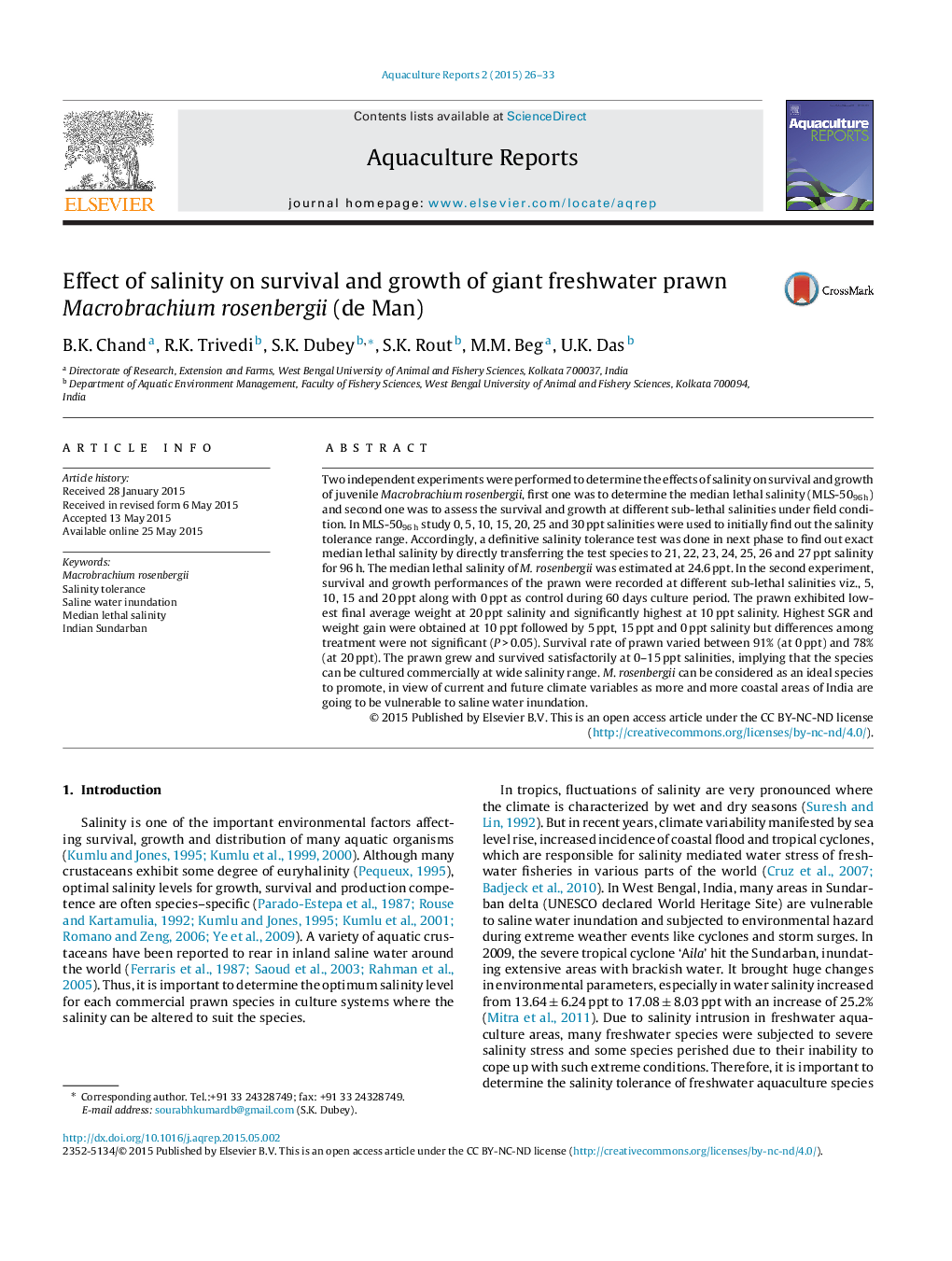| کد مقاله | کد نشریه | سال انتشار | مقاله انگلیسی | نسخه تمام متن |
|---|---|---|---|---|
| 4437964 | 1620278 | 2015 | 8 صفحه PDF | دانلود رایگان |

• The giant freshwater prawn M. rosenbergii is a candidate species for commercial aquaculture in the Indo-Pacific region.
• The objectives are to determine median lethal salinity (MLS-5096 h) of M. rosenbergii, and to assess the survival and growth rates at different sub-lethal salinities.
• The median lethal salinity of M. rosenbergii was estimated at 24.6 ppt salinity.
• When rearing the prawns at different sub-lethal salinities viz., 5, 10, 15 and 20 ppt along with freshwater, the prawn exhibited lowest final average weight at 20 ppt salinity and significantly highest at 10 ppt salinity. Highest SGR and weight gain was obtained when prawns were cultured at 10 ppt followed by those cultured at 5 ppt, 15 ppt and 0 ppt but differences among treatment were not significant (P > 0.05). Survival rate of prawns varied between 91% (at 0 ppt) and 78% (at 20 ppt).
• The prawn grew and survived satisfactorily at 0–15 ppt salinities, implying that the species can be cultured commercially at wide salinity range.
• In view of current and future climate variables, more and more coastal areas of India are going to be vulnerable to saline water inundation. Under such scenario, M. rosenbergii can be considered as an ideal species to promote.
Two independent experiments were performed to determine the effects of salinity on survival and growth of juvenile Macrobrachium rosenbergii, first one was to determine the median lethal salinity (MLS-5096 h) and second one was to assess the survival and growth at different sub-lethal salinities under field condition. In MLS-5096 h study 0, 5, 10, 15, 20, 25 and 30 ppt salinities were used to initially find out the salinity tolerance range. Accordingly, a definitive salinity tolerance test was done in next phase to find out exact median lethal salinity by directly transferring the test species to 21, 22, 23, 24, 25, 26 and 27 ppt salinity for 96 h. The median lethal salinity of M. rosenbergii was estimated at 24.6 ppt. In the second experiment, survival and growth performances of the prawn were recorded at different sub-lethal salinities viz., 5, 10, 15 and 20 ppt along with 0 ppt as control during 60 days culture period. The prawn exhibited lowest final average weight at 20 ppt salinity and significantly highest at 10 ppt salinity. Highest SGR and weight gain were obtained at 10 ppt followed by 5 ppt, 15 ppt and 0 ppt salinity but differences among treatment were not significant (P > 0.05). Survival rate of prawn varied between 91% (at 0 ppt) and 78% (at 20 ppt). The prawn grew and survived satisfactorily at 0–15 ppt salinities, implying that the species can be cultured commercially at wide salinity range. M. rosenbergii can be considered as an ideal species to promote, in view of current and future climate variables as more and more coastal areas of India are going to be vulnerable to saline water inundation.
Journal: Aquaculture Reports - Volume 2, November 2015, Pages 26–33